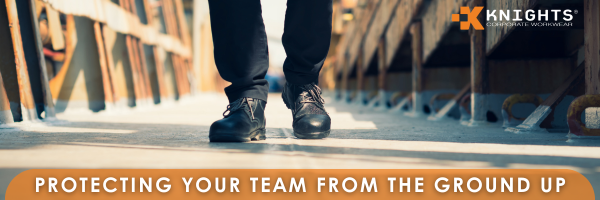The Buyer’s Guide to Safety Footwear: Protecting Your Team from the Ground Up
Apr 7 2025 2:27PM

When it comes to protecting your workforce, Safety Footwear plays a vital role. The right choice can prevent injury, boost morale, and even improve productivity. But with so many options, standards, and safety codes, how can you be sure you’re making the right choice for your team?
This guide is here to help Procurement Professionals, Health and Safety Managers, and Team Leaders understand what matters when sourcing Safety Footwear.
Why Safety Footwear Matters
Safety footwear is a critical part of any PPE strategy. Foot injuries can lead to time off work, long-term damage, and costly compensation claims. The Health and Safety Executive (HSE) reports that over 20% of workplace injuries involve the lower limbs.
But the importance goes beyond compliance. Good footwear means better comfort, improved posture, and more energy throughout the day; factors that can directly impact your team's performance.
The Core Standards
Safety footwear sold in the UK and Europe must meet EN ISO 20345 standards. This includes several categories based on features and protection levels:
- SB: Basic safety footwear (with toecap protection)
- S1 / S1P: Anti-static, energy absorption, closed heel (P = penetration-resistant sole)
- S2: Adds water resistance
- S3: Adds a cleated sole and midsole protection
Always check certification and ensure your supplier offers properly marked, compliant footwear.
Matching Footwear to the Risk
Different working environments carry different hazards. The best footwear is the one tailored to the risk:
| Environment
|
Footwear Needs
|
| Warehouses
|
Slip resistance, comfort, and ankle support
|
| Construction
|
Steel or composite toecaps, penetration-resistant soles
|
| Cold storage
|
Thermal insulation and waterproofing
|
| Wet/outdoor areas
|
Cleated soles, water resistance, and anti-slip
|
| Electrical environments
|
Anti-static or ESD protection
|
Key Features to Consider
- Toe Cap: Steel for strength, or composite for lighter weight and no metal detection issues.
- Midsole Protection: Essential for construction or sharp-object risk.
- Slip Resistance: Look for SRC-rated soles for slip resistance on ceramic and steel surfaces.
- Waterproofing: A must for outdoor or wet environments.
- Comfort & Fit: Insoles, arch support, and correct sizing reduce fatigue and risk of long-term injury.
When to Replace Safety Footwear
Even the best boots wear out. Here's when it's time to replace:
- Worn tread or soles
- Visible damage to the upper
- Compromised toecaps
- Persistent discomfort
Tip: Review safety footwear every 6-12 months depending on use intensity.
Common Pitfalls in Procurement
Avoid these common mistakes:
- Buying on price alone
- Ignoring gender-specific or wide/narrow sizing
- Forgetting comfort = compliance (if it's uncomfortable, staff won't wear it!)
Add Value with Knights Corporate Workwear
- Expert-led consultations to match gear to your site hazards
- Options for a unified look
- Fit trials available
- Fast delivery & ongoing supply
We're here to help you protect your people while making procurement simple.
Ready to upgrade your safety footwear strategy? Contact us at sales@knightsuk.com
